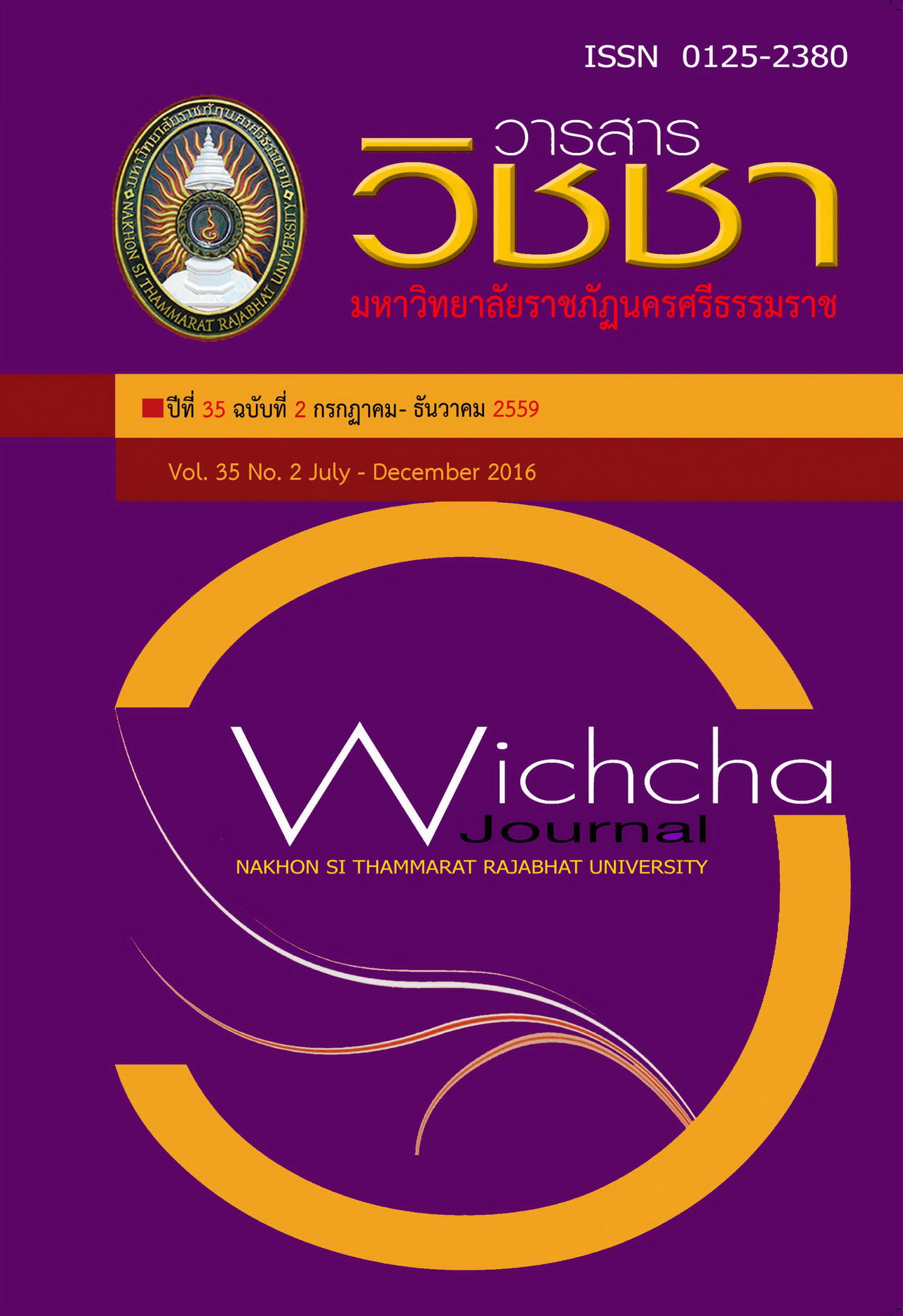การสังเคราะห์อนุภาคนาโนซิงค์ออกไซด์โดยวิธีเคมีสีเขียวสำหรับปรับปรุงการย้อมสีผ้าฝ้ายด้วยสีธรรมชาติ ZnO Nanoparticles Synthesized by Green Chemistry Methods for improvement of Cotton Fabric Dyeing with Natural Dye
Main Article Content
Abstract
การศึกษานี้มีวัตถุประสงค์เพื่อปรับปรุงผ้าฝ้ายด้วยอนุภาคนาโนซิงค์ออกไซด์ที่สังเคราะห์โดยใช้เคมีสีเขียว ที่ซึ่งใช้สารสกัดของพืชในท้องถิ่น ได้แก่ เค็ง(Dialium cochinchinense Pierre)ผักเสี้ยน(Cleoma viscosa L.) ยอ(Morinda citrifolia) มะรุม(Moringa oleifera) มะขาม(Tamarindus indica L.) มะหาด (Artocarpus lacucha) ชะพลู (Piper nigrum L.) และราชพฤกษ์ (Cassia fistula) ซิงค์ไนเตรตถูกเปลี่ยนรูปจากซิงค์ไออนเป็นสารประกอบเชิงซ้อนของซิงค์กับสารสกัดจากพืช จากนั้นเมื่อนำมาเผาที่อุณหภูมิ 400 องศาเซลเซียส เป็นเวลา 1 ชั่วโมง จะได้อนุภาคนาโนซิงค์ออกไซด์จากสารสกัดพืชทั้งหมดที่ศึกษาพบว่าสารสกัดจากใบเค็งดีที่สุดเนื่องจากให้ปริมาณของซิงค์ออกไซด์สูงที่สุดเมื่อเปรียบเทียบกับสารสกัดจากพืชชนิดอื่นๆ พิสูจน์เอกลักษณ์อนุภาคนาโนที่สังเคราะห์ได้โดยใช้เทคนิคยูวี-วิสสิเบิล สเปกโทรสโกปีกล้องจุลทรรศน์อิเล็กตรอนแบบส่องกราด (SEM)การเลี้ยวเบนของรังสีเอกซ์(XRD) และฟูเรียร์ทรานสฟอร์มอินฟราเรดสเปกโทรสโกปี(FTIR) จากผลของแถบการดูดกลืนแสงยูวี-วิสิเบิลพบว่า ค่าการดูดกลืนแสงสูงสุดของอนุภาคซิงค์ออกไซด์ปรากฏที่ความยาวคลื่น 347 นาโนเมตรจากภาพ SEMแสดงถึงอนุภาคที่เกิดการเกาะกลุ่มกันของนาโนซิงค์ออกไซด์มีลักษณะเป็นทรงกลมของผลิตภัณฑ์สอดคล้องกับ ICDD หมายเลข 00-0361451 แสดงว่าผลิตภัณฑ์ที่ได้เป็น ZnO ที่มีโครงสร้างแบบเวอร์ตไซท์ขนาดผลึกเฉลี่ยของอนุภาคนาโนซิงค์ออกไซด์คำนวณโดยใช้สมการของเชอเรอร์เท่ากับ26.05 นาโนเมตรและ FTIR ปรากฎพีกแสดงการยึดเกาะกันของ Zn-O ที่ 1025 และ 415 ซม.-1 นำผ้าฝ้ายที่ดัดแปรด้วยอนุภาคนาโนดังกล่าวมาย้อมสีด้วยสีย้อมสีน้ำตาลจากเส้นใยมะพร้าวแก่ พบว่าความเข้มของสี (K/S) ความคงทนของสีต่อแสงแดด ความคงทนของสีต่อการซักล้าง และความสามารถต้านเชื้อแบคทีเรียชนิด Staphylococcus aureus ของผ้าฝ้ายดัดแปรด้วยอนุภาคนาโนซิงค์ออกไซด์มีค่าสูงกว่าผ้าฝ้ายที่ไม่มีการดัดแปร
The study aimed to investigate the modification on cotton fabric with thezinc oxide nanoparticles synthesized using green chemistry by the local plants extract such as Kheng (Dialium cochinchinense Pierre), Wild spider flower (Cleoma viscosa L.), Cheese fruit (Morinda citrifolia), Moringa (Moringa oleifera), Gam chum (Tamarindus indica L.), Lakoocha (Artocarpus lacucha), Piperaceae (Piper nigrum L.) and Golden shower (Cassia fistula). Zinc nitrate was transformed from zinc ion to Zn complex formation by using plants extract as template. ZnO nanoparticles were performed by the calcination of Zn complex at 400 oC for 1 h. Among the plant extract, Kheng leaf was the best source of extracts because it gave the highest amount of the as-synthesized zinc oxide nanoparticles than the others. The assynthesized ZnO nanoparticles were characterized by UV-Visible spectroscopy, scanning electron microscopy (SEM), x ray diffraction diffractometry (XRD) and Fourier transform infrared spectroscopy (FTIR). The UV-Visible absorption spectrum shows a strong resonance centered on the surface of zinc oxide particles at 347 nm. SEM image illustrated that the resulting products were an aggregation of the ZnO spherical like shape of calcinated ZnO nanoparticles was matched well with ICDD no. 00-0361451 indicating that the products were ZnO crystallized in wurtzite structure.The average crystallitesize of ZnO was estimated according to Scherrer’s equation is 26.05 nm. Fourier transform infrared spectroscopy (FTIR) shows that the
bandscorresponding to (Zn–O) appeared at 1025 and 415 cm-1. The cotton fabric was modified with the ZnO nanoparticles prior to dyeing with coconut coir fiber dye which obtained brown color. Results of the dyeing showed that the color intensity (K/S), the color fastness of sunlight and color fastness to washing and antibacterial activity Staphylococcus aureus of the modified cotton fabric were higher than that of unmodified one.
Article Details
เนื้อหาและข้อมูลในบทความที่ลงตีพิมพ์ในวารสารวิชชา มหาวิทยาลัยราชภัฏนครศรีธรรมราช ถือเป็นข้อคิดเห็นและความรับผิดชอบของผู้เขียนบทความโดยตรง ซึ่งกองบรรณาธิการวารสารไม่จำเป็นต้องเห็นด้วยหรือร่วมรับผิดชอบใด ๆ
บทความ ข้อมูล เนื้อหา รูปภาพ ฯลฯ ที่ได้รับการตีพิมพ์ในวารสารวิชชา มหาวิทยาลัยราชภัฏนครศรีธรรมราช ถือเป็นลิขสิทธ์ของวารสารวิชชา มหาวิทยาลัยราชภัฏนครศรีธรรมราช หากบุคคลหรือหน่วยงานใดต้องการนำข้อมูลทั้งหมดหรือส่วนหนึ่งส่วนใดไปเผยแพร่ต่อหรือเพื่อการกระทำการใด ๆ จะต้องได้รับอนุญาตเป็นลายลักษณ์อักษรจากวารสารวิชชา มหาวิทยาลัยราชภัฏนครศรีธรรมราชก่อนเท่านั้น
The content and information in the article published in Wichcha journal Nakhon Si Thammarat Rajabhat University, It is the opinion and responsibility of the author of the article. The editorial journals do not need to agree. Or share any responsibility.


